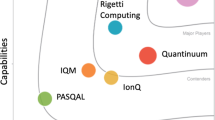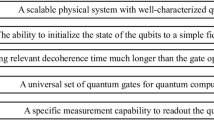Abstract
We propose a quantum branch-and-bound algorithm based on the general scheme of the branch-and-bound method and the quantum nested searching algorithm and examine its computational efficiency. We also compare this algorithm with a similar classical algorithm on the example of the travelling salesman problem. We show that in the vast majority of problems, the classical algorithm is quicker than the quantum algorithm due to greater adaptability. However, the operation time of the quantum algorithm is constant for all problem, whereas the classical algorithm runs very slowly for certain problems. In the worst case, the quantum branch-and-bound algorithm is proved to be several times more efficient than the classical algorithm.
Similar content being viewed by others
References
A. Ahuja, S. Kapoor, “A quantum algorithm for finding the maximum,” e-print arxiv.org/abs/quant-ph/9911082
A. Ambainis, “Quantum search algorithm,” SIGACT News, 35, No. 2, 22–35 (2004).
C. Bennett, E. Bernstein, G. Brassard, and U. Vazirani, “Strengths and weaknesses of quantum computing,” SIAM J. Comput., 26, No. 5, 1510–1523 (1997).
P. Billingsley, Probability and Measure, Wiley, New York (1995).
G. Brassard, P. Høyer, M. Mosca, and A. Tapp, “Quantum amplitude amplification and estimation,” Quantum Comput. Quantum Inform. Sci., Contemp. Math. Ser., 305, 53–74 (2002).
N. J. Cerf, L. Grover, and C. P. Williams, “Nested quantum search and structured problems,” Phys. Rev. A, 61, No. 3, 032303 (2000).
A. Childs, S. Kimmel, and R. Kothari, “The quantum query complexity of read-many formulas,” Lect. Notes Comput. Sci., 7501, 336–348 (2012).
A. M. Childs, A. J. Landahl, and P. A. Parrilo, “Improved quantum algorithms for the ordered search problem via semidefinite programming,” Phys. Rev. A, 75, No. 3, 032335 (2007).
R. Cleve, D. Gavinsky, and D. L. Yonge-Mallo, “Quantum algorithms for evaluating min-max trees,” in: Theory of Quantum Computation, Communication, and Cryptography, Lect. Notes Comput. Sci., 5106, (2008), pp. 11–15.
M. Cortina-Borja and T. Robinson, “Estimating the asymptotic constants of the total length of Euclidean minimal spanning trees with power-weighted edges,” Stat. Probab. Lett., 47, No. 2, 125–128 (2000).
T. G. Crainic, B. Le Cun, and C. Roucairol, “Parallel branch-and-bound algorithms,” in: Parallel Combinatorica and Optimization, Wiley, New York (2006), pp. 1–28.
C. Dürr, M. Heiligman, P. Høyer, and M. Mhalla, “Quantum query complexity of some graph problems,” SIAM J. Comput., 35, No. 6, 1310–1328 (2006).
C. Dürr and P. Høyer, “A quantum algorithm for finding the minimum,” arxiv.org/abs/quant-ph/9607014
E. Farhi, J. Goldstone, and S. Gutmann, “A quantum algorithm for the Hamiltonian NAND tree,” Theory Comput., 4, 169–190 (2008).
E. Farhi, J. Goldstone, S. Gutmann, M. Sipser, “Invariant quantum algorithms for insertion into an ordered list,” arxiv.org/abs/quant-ph/9901059
I. P. Gent and T. Walsh, “The TSP phase transition,” Artificial Intelligence, 88, No. 1, 349–358 (1996).
L. K. Grover, “A fast quantum mechanical algorithm for database search,” in: Proc. 28 Ann. Symp. on the Theory of Computing, ACM Press, New York (1996), pp. 212–219.
P. Høyer, J. Neerbek, and Y. Shi, “Quantum complexities of ordered searching, sorting, and element distinctness,” Algorithmica, 34, No. 4, 429–448 (2002).
H. Kesten and S. Lee, “The central limit theorem for weighted minimal spanning trees on random points,” Ann. Probab., 6, No. 2, 495–527 (1996).
L. A. B. Kowada, C. Lavor, R. Portugal, and C. M. H. de Figueiredo, “A new quantum algorithm for solving the minimum searching problem,” Int. J. Quantum Inform., 6, No. 3, 427–436 (2008).
S. Mandrà, G. G. Guerreschi, and A. Aspuru-Guzik, “Faster than classical quantum algorithm for dense formulas of exact satisfiability and occupation problems,” New J. Phys., 18, No. 7, 073003 (2016).
B. W. Reichardt, “Reflections for quantum query algorithms,” in: Proc. 22 ACM-SIAM Symp. on Discrete Algorithms (2011), pp. 560–569; arxiv.org/abs/1005.1601
M. Steele, “Growth rates of Euclidean minimal spanning trees with power weighted edges,” Ann. Probab., 16, No. 4, 1767–1787 (1988).
H. Wagner, Principles of Operations Research, Prentice Hall, Englewood Cliffs, New Jersey (1969).
T. J. Yoder, G. H. Low, and I. L. Chuang, “Fixed-point quantum search with an optimal number of queries,” Phys. Rev. Lett., 113, 210501 (2014).
W. Zhang, State-Space Search: Algorithms, Complexity, Extensions, and Applications, Springer-Verlag (1999).
D. A. Zholobov, Introduction in Mathematical Programming [in Russian], MEPhI, Moscow (2008).
Author information
Authors and Affiliations
Corresponding author
Additional information
Translated from Itogi Nauki i Tekhniki, Seriya Sovremennaya Matematika i Ee Prilozheniya. Tematicheskie Obzory, Vol. 138, Quantum Computing, 2017.
Rights and permissions
About this article
Cite this article
Markevich, E.A., Trushechkin, A.S. Quantum Branch-and-Bound Algorithm and its Application to the Travelling Salesman Problem. J Math Sci 241, 168–184 (2019). https://doi.org/10.1007/s10958-019-04415-6
Published:
Issue Date:
DOI: https://doi.org/10.1007/s10958-019-04415-6
Keywords and phrases
- quantum computing
- quantum computer
- quantum search
- Grover’s algorithm
- branch-and-bound method
- travelling salesman problem




